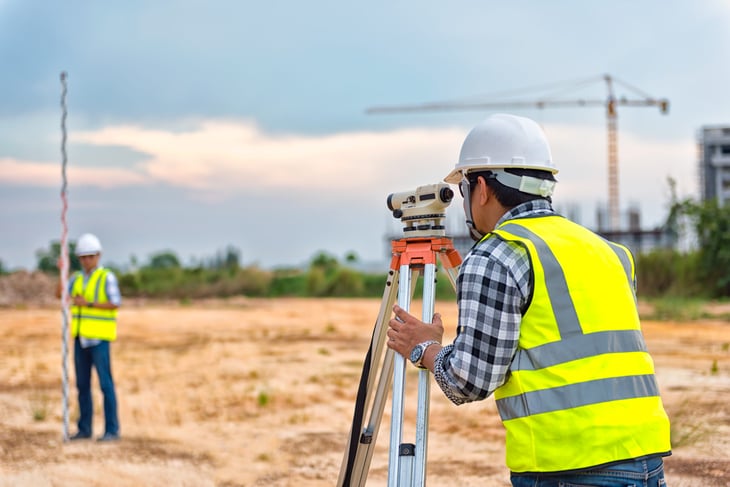
Editor's Note: This story originally appeared on Point2.
Many of us fantasize about building our ideal house on the perfect parcel of land.
However, aside from the construction part, buying a lot is a rather challenging process itself. But if you yearn to make your dream a reality, it’s not as impossible as it can seem.
In this comprehensive guide to purchasing land, we’ll examine the entire process before discussing the various pros and cons.
1. Create a Budget

When it comes to budgeting to buy land, there are several things you’ll need to consider in addition to those encountered when purchasing a home. Some examples include:
- Price of the land
- Soil and water tests
- Utility hookups
- Rezoning fees and impact fees, if required
2. Hire a Specialized Real Estate Agent

A good agent can make any real estate transaction flow more smoothly, but a professional specializing in land is an invaluable ally when looking to buy a plot.
Not only will they know all the complicated jargon, but they’re familiar with the entire process.
As such, they can help you with everything from finding your perfect parcel to negotiating a killer deal and assisting with paperwork and financing options.
3. Search for a Plot of Land

With a budget in mind and an expert real estate agent on your side, you can now start searching for a plot of land that fits the bill. Here are a few tips to help you out:
- Use online maps to scope out wider areas: Modern online mapping services can be a fantastic tool to help you find the rough area you’d like to settle down in, giving you an idea about distances to towns and other amenities.
- Search offline, as well as online: An online search can be a great way to get a rough idea of prices and what’s available, but it’s also wise to do some offline research. Offline classified ads and insider knowledge from your agent can help you discover exclusive listings that might not be publicly advertised online yet.
- Research the local market of any plot you’re prospecting: Once you find a suitable plot, look over recent sales data in the area to see whether it’s in decline or up and coming and look at comparables to gauge the price point. Meanwhile, a drive through the area can give you a good idea about the local infrastructure while allowing you to seek alternative plots.
- Greenfield versus brownfield land: Greenfield land refers to land that has never been built on before, while brownfield land has previously been developed. Both have their pros and cons and may be subject to different planning requirements.
- Search for free land: Both the U.S. and Canada offer free land incentives to encourage homesteaders to build in certain parts of the country. While conditions often apply, it’s a great way to save cash.
4. Research Your Plot and Carry out a Survey

When you find a plot that looks like it’ll work for you, it’s time to dig a little deeper. Check the most recent land survey, and if there hasn’t been one in the last couple of years, take one out.
Boundary disputes can be a big headache later on, and a survey can confirm whether there are any encroachments, easements or restrictions to be aware of, as well as define the legal boundaries.
In addition, a survey will measure the elevation and slope of the land, as well as identify floodplains, which is essential to know before you start laying foundations.
Also, be sure to check whether there are any zoning restrictions in place. With the wrong type of zoning, you won’t be able to build a home on your plot. It is sometimes possible to have the zoning changed, but it’s something you need to know about in advance, regardless, as it can cause long delays.
It’s also a good idea to look over any recent environmental tests to ensure no traces of contaminants are present.
Finally, check for utility access. It’s essential to know if you’ll have access to potable water, electricity, roadways and the internet, among others, or if you’ll have to manage these yourself.
5. Figure out Financing

If you’re happy with your plot, the next step would be to make an offer, but first, you need to have your financing figured out.
A lot of land is purchased as a cash transaction, and you’ll need to make sure you have proof of funds ready to show the seller when you make an offer.
Not planning to pay in cash? Many lenders consider land purchases a high-risk investment, making it difficult to get a conventional loan. Even those that do offer a loan will generally require a large down payment, sometimes as much as 50%.
However, suppose you have building plans in place and intend to build immediately. In that case, it’s a little easier to qualify, with both Canada and the U.S. offering a variety of financing options for those buying land.
Finance Options in Canada and U.S.

Residents of Canada can choose from:
- Construction mortgage: aimed at those buying land to build on
- Land mortgage: similar to a conventional loan but typically with higher interest rates and a larger down payment
- Agricultural loan: designed for land that will be used for agricultural purposes but not for building a home
Meanwhile, residents of the U.S. can take advantage of the following:
- Construction-to-permanent (CP) loan: by far the most common choice, it allows borrowers to finance both the purchase of the land and the construction of their home simultaneously. Once construction is complete, it essentially becomes a regular mortgage
- Lot loans: aimed at borrowers who aren’t planning to build immediately, they require a sizeable down payment and have high interest rates
- Owner financing: the seller agrees to finance the purchase. While the down payment is typically lower, the interest rate is usually higher.
In any case, it helps to have a stellar credit score and a good chunk of cash for a down payment if you’re planning to seek financing to buy land.
6. Make Your Offer

When you have secured financing, now you can confidently make the seller an offer.
It’s well worth making a conditional offer, so be sure to add contingencies that enable you to walk away from the sale if it turns out the land isn’t fit for building on — for example, the result of the soil test, the access to utilities, etc.
7. Conduct Land Inspections

With your offer accepted, now is the time to conduct several inspections:
- Soil test: this will confirm that the land can safely be built on and advise what kind of foundations are required, as well as any limitations to the build
- Title search: ensures that there are no liens or claims on the land
- Zoning regulations: it’s well worth double-checking to be absolutely sure you can build a home on your land
Be sure to hire professionals to carry out these inspections, preferably reliable third parties, to ensure you won’t have any problems once the land is in your name.
If everything is in order, you can finalize the sale and start building your dream home.
Is Buying Land a Good Investment?

Now you know how to buy land, it’s essential to figure out if it’s a worthwhile investment. Everyone’s circumstances differ, but here are the main pros and cons.
The Advantages of Buying Land

Of course, the most significant advantage to buying land is that it allows you to design and build your dream home.
It leaves you free to use the building materials and systems you want, making it easier to construct an eco-friendly home, one that’s off-grid, or one that perfectly suits the needs of your family. Plus, with the proper licensing, you could self-build your new home, saving a lot of money.
A plot of land can also be an excellent investment, even if you leave it empty. It requires much less maintenance than a house would, and unlike a house that tends to depreciate in value as time goes by, land tends to increase.
Finally, buying land offers great money-saving incentives for those on a budget. Free land incentives in both the U.S. and Canada can save you thousands of dollars.
Meanwhile, in the U.S., land buyers can qualify for a USDA (U.S. Department of Agriculture) loan, which doesn’t require a down payment.
The Disadvantages of Buying Land

The most significant drawback when buying land for building a house is that it’s a longer, more complicated process than simply purchasing a home. There’s a lot of research involved and many loops to jump through before you can start thinking about building.
Another disadvantage is that it limits your choice of location considerably. Indeed, outside of rural areas, you can struggle to find vacant land.
So, if you hope to be close to the action, you’ll struggle to locate a suitable lot.
Finally, financing the purchase of land is much more complex than financing a home, and even successful applicants are subject to high interest rates.





Add a Comment
Our Policy: We welcome relevant and respectful comments in order to foster healthy and informative discussions. All other comments may be removed. Comments with links are automatically held for moderation.